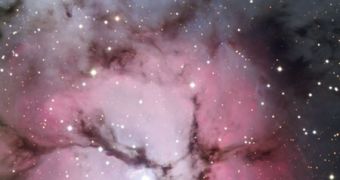Astronomers at the European Southern Observatory (ESO) have recently made a new addition to their arsenal of breathtaking images, when they have used their Chile-based facility to gain a new, highly detailed image of the Trifid Nebula, also known as the Trisected Nebula. The formation, located some 5,500 light-years away, is a stellar nursery, which is made up of an extremely rare arrangement of three different nebulas, Space reports.
The new observations provide experts with a wealth of information about the life of stars, from their earliest days, when they are simply cosmic dust and gas clouds, to the time when they first collapse onto themselves, and start shinning. Upon their formation, they generate important amounts of heat and solar winds, which contribute to stirring the gas inside the massive nebula. With time, all of the black streams of gas that can be seen in the image will gradually collapse into stars, giving birth to new, blue ones.
The high-detail image was collected by the Wide-Field Imager camera, which is attached to the MPG/ESO 2.2-meter telescope, at the La Silla Observatory. It was captured entirely in visible light, and no overlays were used to augment its beautiful colors. The entire formation draws its name from the fact that it has three dark lanes crossing its bright center, which is also the area with the most intense stellar-formation processes going on. It was first discovered by Charles Messier in June 1764, but got the name Trifid from John Herschel, some 60 years later, when the lanes were also noticed.
The Nebula is surrounded by an azure hue because of the myriad of newly formed stars, which emit blue light far more efficiently than red light. Additionally, visible light reflects off various layers of gas that can be found in and around the formation, further accentuating its colors. Another factor responsible for the wonderful appearance is the fact that molecules in the gas and dust clouds reflect blue light better as well.

 14 DAY TRIAL //
14 DAY TRIAL //